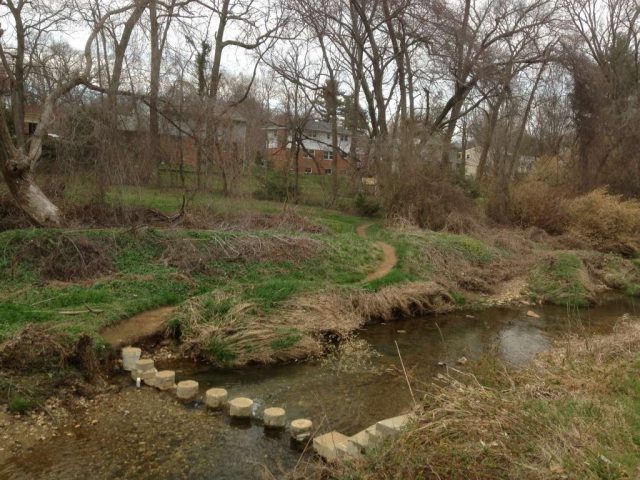I ran by it dozens of times on my routine eight-mile loop on Great Falls and Westmoreland. Down at the bottom of the hill near Lemon Road, it looked like nothing more than a neighborhood shortcut..
I don’t remember what prompted me to actually check out what turned out to be the Pimmit Run Trail, but I do remember the odd sense of wonder that took hold when I did. I had some exploring to do.
That, understandably, sounds strange. How lost can you get in McLean? It might be counterintuitive, but the prospect of somehow losing my bearings inside the Beltway only made the prospect of exploration more interesting. It wasn’t so much about charting new territories, but seeing where I’d end up. I knew the path from Great Falls Road would eventually get me to Westmoreland. When I saw that the trail continued on the other side of the street, a little to the left, all bets were off.
I’m not a fervent trail runner. It’s not that I dislike them, but my body has always held up well on pavement and I figured I had better things to do than spend time traveling to run in a park when it was all the same to me. Well, now I didn’t have to choose. Rather than tearing through the trails, the mildly technical terrain, especially north of Old Dominion Road, forced me to savor the experience.
The fun for me became finding out where I’d pop out if I left the park.
“Tucker Ave? I don’t even know where that is!“
I fancied myself looking for a route to the Potomac River. I knew I was headed in the right direction, there had to be a way…
There is, but it’s tricky. And although I fear I am ruining the experience you could have exploring for yourself – for me, the trial and error was half of the fun – here’s some specific direction to keep you on track.
If you reach the Highlands Swim and Tennis Club, head up Bryan Branch Road to Linway Terrace. After a quick left on Kirby Road, you have a choice. Keep going on Kirby, head into the Marie Butler Leven Preserve and take one of the wooded trails until you reach Maddux. Or take a right on Chesterbook and left on Maddux.
On your right, shortly after 1607, you’ll see a path to the downstream section, which will bring you along the George Washington Parkway and onto the Potomac Heritage Trail, where you can get off at the Chain Bridge.
There are some creek crossings, and sometimes your foot will have to take the plunge to take the next step. But each next step will make you appreciate what you’ll continue to find.
The Pimmit Run Trail is a 1.5-mile run from the West Falls Church Metro Stop. One section of the trail that purportedly connects to Olney park in Pimmit Hills is impassible because of fencing under the Dulles Toll Road.
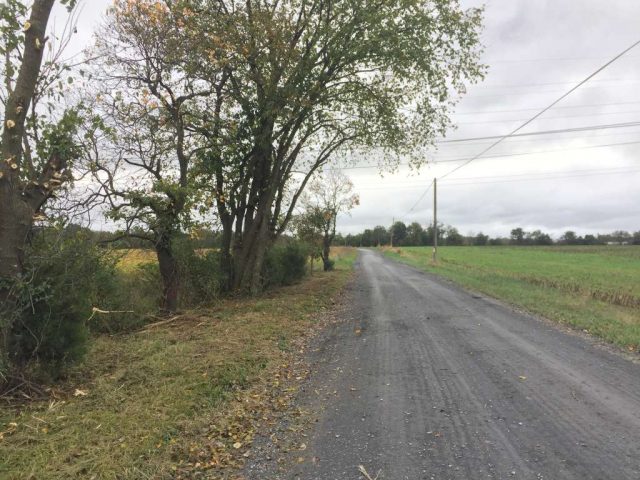
Poolesville, Md.
Length: 10.1 miles
Description: A mostly-natural surface loop in rural Montgomery County that gives you five miles of the C&O Canal Towpath Trail, starting at Edward’s ferry and running to White’s Ferry, then back on River Road.
As fog rolled rapidly though the Cumberland Mountains in Eastern Tennessee, it created a strobe-like effect as dawn was breaking. From a fire tower, Rockville’s John Kelly could be seen, then not seen, then seen again… climbing a long hillside cleared for power lines.
Conrad Laskowski and Ed Aramayo watched Kelly pick up something orange, shake it around and put it on his head.
“It was a wool hat,” Laskowski said.
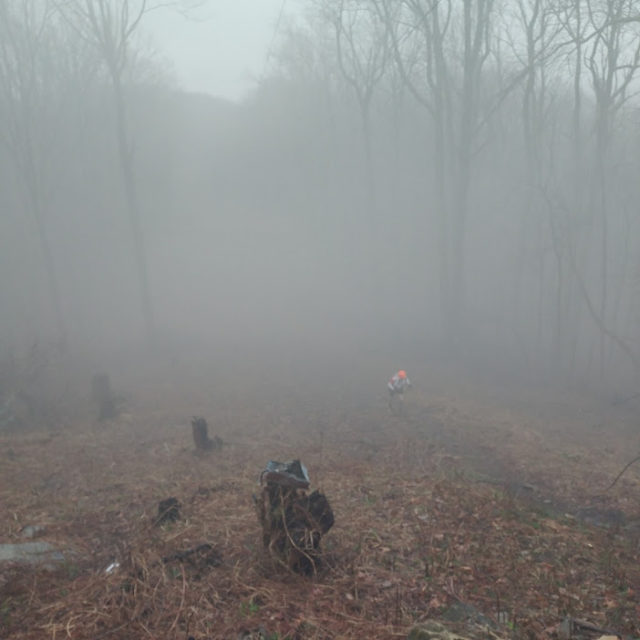
Even five days later, the excitement perked up Kelly’s otherwise calm even-keeled demeanor.
“I spotted that orange hat I’m like, ‘Score! this is awesome!” he said. “It’s one of the most exciting things I’ve ever seen.”
That hat, along with the plastic grocery bag he had fashioned into a poncho, helped Kelly, 32, mitigate the cold and rain and repurpose them to help propel him forward, with just a few miles to go in what was likely 130 miles over 59 hours and 31 minutes, over some of the most rugged terrain in distance running.
He became the 15th person to complete the Barkley Marathons over 30 years, the first from the Washington, D.C. area.
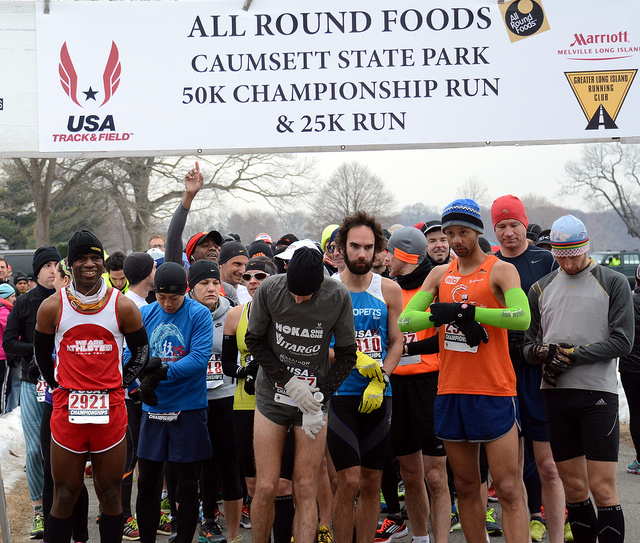
We talk a lot about walls in marathoning. We push through them–effortlessly or gasping for breath–on our way to the finish line. Race over.
One problem: the finish line is the real wall. No negotiations. This requirement doesn’t move for any of us. We must change, not the race. The most successful marathoners don’t break through this final barrier–they hit it, full force.
Ethan Coffey has a unique relationship with walls: by his own admission, when he faces the mystique of the 26.2, he’s still trying to hit the mark.
His January 2014 victory in the Charleston (S.C) Marathon in 2:34:06 set a new personal standard for a runner who “used to throw up from nerves before races in high school,” while a student at Chantilly.
“When I won the Charleston race,” says Coffee, “I realized I really had the potential to win marathons. I’d like to train for more.”
A few weeks and a few more miles later, Coffey still has staying power.
On March 1, Coffey, now a Knoxville resident, definitively won the USATF 50k Road Championships at Caumsett State Park on Long Island, N.Y., posting a new course record of 2:53:32.78 and upsetting four-time champion Michael Wardian‘s (Arlington, Va.) 2008 record of 2:55:05 in the process. Ethan estimated Wardian to be his most likely competitor for many reasons, with the veteran runner’s historically consistent performances topping the list. However, Wardian finished the race with a time of 2:59:31.69, placing second after progressively slowing past mile 10.
“At mile seventeen, I knew I was feeling good. No wall or anything.” says Coffey, “When [Wardian] realized he wasn’t going to beat me, he dropped off.”
Adding to Coffey’s victory, back-to-back reigning champion Joseph Gray (Renton, Wa.) held strong in an initial three-man pack, but began back-pacing with Wardian, only to quit the race entirely. This was an unexpected underperformance, considering Gray’s near record setting win in 2013.
“In the last 10k it was just me,” says Coffey, “My legs really felt good. I was able to just keep going after everybody else dropped off.”
Coffey also easily beat out Josh Ferenc (Saxtons River, Vt.) who trailed into a late third place with a time of 3:04:16.91.
After besting two juggernauts of the 50k distance, one would think a runner like Coffey would be relatively satisfied. He broke through several barriers, right? He set a course record. He went farther, faster. He won.
But, perhaps unsurprisingly, like all winners, Coffey looks to past runs to understand his potential for performance. He judges himself by his failures as much as his successes. And, though a 50k is not a marathon, he uses what he knows about his relationship with the two distances to define and redefine himself as a runner.
“I’ve never been intimidated by the distance of a marathon. I just kind of went past that distance pretty easily. But my marathons haven’t always gone very well for me,” he says. “I think my 50ks, though, have gone better than my marathons. In the 50k, I don’t usually struggle with the wall. But I think I have been lucky.”
The 50k winner knows, though, that luck isn’t everything. And sometimes a perceived weakness at one distance can be a distinct advantage in a different race. Clearly, Coffee’s perceived struggles with the marathon have forced him into a different running bracket and led him to his most recent victory; however, he expresses mixed emotions about his relationship with the more iconic distance.
“People have tried to blame my poor marathon performance on getting too worked up,” he says. “But that’s not it. I’m definitely calm. I take it all seriously. But with the longer distance, I feel more in control of the run. I’m not sure why.”
Not getting “worked up” allows Coffey the opportunity to run smarter and take down opponents like Wardian and Gray. “I had done the math beforehand. Basically, I went out to win. I think that’s why things went pretty well for me,” he says, “I knew I had a chance. In general, I’m able to pace myself better in the 50K.”
But there is also a residual part of Coffee that still does want to get worked up. Wants to hit a wall. Hard.
“My goal is to break 2:20 in the marathon,” he says, “The real goal is to run an Olympic goals qualifier. And I think I could do that. I see myself able to do that.”
One more thing Coffey will be doing in the near future will be running the Boston Marathon. And, of course, he has set very specific goals–goals that speak to the hybrid nature of his marathoner/ultramarathoner identity. “I’ll be running Boston, but I’m going to do it a little differently,” he says, “I’m planning on running the course twice. 52 miles in less than six hours. That’s my goal.”
With such a decisive 50k win and undoubtedly promising marathon potential at his feet, perhaps it would be easy to wonder why Ethan Coffey doesn’t just pick a side of the 26.2 and run with it. But why should he have to? Coffee may, indeed, be the kind of runner who can hit a barrier and then run past it. Maybe he is that lucky.
Or maybe, as he’s figuring out how to deal with the path ahead, he is just listening to his own confident advice. “I just kind of realize that nobody outside of myself can tell me how I should run,” he says, “What I do is impressive enough.”
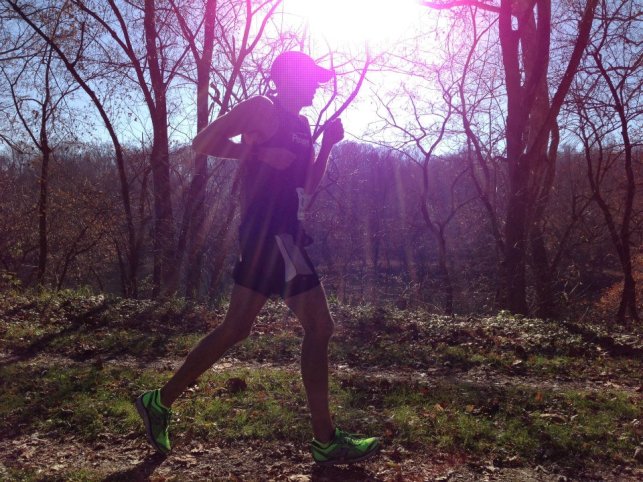
Thanks to challenges from fast marathoners and excellent weather, the JFK 50 Mile winners smashed the course records Saturday in western Maryland.
[button-red url=”http://www.jfk50milemdt.org/2012/JFKResultslive-01.txt” target=”_self” position=”left”] Results [/button-red]A year after David Riddle took a little off the top, Max King lopped more than five minutes off to lower the men’s record to 5:34:58. Trent Briney, from Boulder, Co. followed in 5:78:56, with Riddle in third in 5:45:17. Canadian Ellie Greenwood (6:11:59) responded to a challenge from Emily Harrison (6:17:16), leading both under the course record. Elissa Ballas, from Colorado, (6:44:45) followed in third.
King is a utility player is distance running, capturing the 2011 world mountain running championship and the XTERRA trail running world championship, but also dipping down to the 3k steeplechase. Race director Mike Spinnler’s strong recruiting push and an opportunity to run what he considered his first fast 50 mile drew King to Maryland.
“To come out here, to one of the largest ultras with such history, it’s really an honor to win,” he said. “I made this race fit into my schedule.”
He sat behind Riddle for the first 16 miles after leaving Boonsboro, over the technical Appalachian Trail portion, before taking off on the C&O Canal Towpath. Despite his trail and mountain running pedigree, King’s training in Bend, Ore. means he’s typically running on less treacherous ground.
“That uneven footing throws you around a bit,” he said. “It wasn’t easy.”
From there, it was a long 27 miles of sporadic spectators and a few cyclists on the towpath. When he hit the stretch to the finish in Williamsport, eight rolling miles of pavement, his effort from the towpath caught up with him and he had to switch his focus from speeding up to holding onto his lead as Briney made up ground.
“I was hurting pretty bad, I just tried to not push it too much,” King said.
Briney never thought he’d have a chance to compete up front. Caught off guard at th
e start, he dropped his clothes a half minute before the gun and went to the line without gels or fluids. Josh Brimhall had one to spare, Briney sucked it down and when he hit the towpath he started moving. “It was the longest 8 miles of my life, I just wanted to finish.”
“I was worried people were way too far ahead of me, I wasn’t going to be part of the race,” he said. “I was supermotivated when I got off the trail.”
Despite his deficit, Briney made up ground, about what anyone could expect out of a 2:12 marathoner who was an alternate for the 2004 Olympic team. He picked off runners but took a while to have a clear idea of his placing. Throughout the ragged running and the haze of the sub-six-minute miles on the towpath, what he took away from the race was the beauty of his surroundings.
“I guess that’s part of the reason we do these races,” he said. “Trail running gives you scenery you don’t always get on the roads.”
While King ran with the lead for the last 34 miles, Greenwood, a Vancouver resident whose JFK finish was her fifth longer than 50 miles this year, was embroiled in a battle with Harrison, who was making her first attempt at the distance. Greenwood was a bit worried, though.
“Her marathon is a good 10 minutes faster than mine, so I had to be sure not to get caught up in racing her,” she said. “You have to have the confidence to run your own race here.”
She did what she could to use her experience, and willingness to push herself based on how she’s responded before, as an advantage.
“People say you can’t win this race on the trail, but psychologically at least it feels good,” she said. Though Greenwood held a lead coming off of the Appalachian Trail, Harrison took it and ran ahead for 14 miles before Greenwood could regain it.
“I started to have trouble with my stomach, I couldn’t eat or drink anything,” she said. “It was even harder because it’s so runnable, by the river, I felt like I was wasting a chance to run fast.”
She caught up to Harrison around 30 miles, passed her a few miles later, then focused far ahead on reeling people in and breaking Devon Crosby-Helms’ 6:29:21 record.
It might seem odd that barely a year removed from her 2:32:55 marathon at Twin Cities that Harrison would move up to an ultra, but her coach Ian Torrence, a Flagstaff, Ariz. resident, said it was crucial to getting her to look past life after the 2012 Olympic Marathon Trials.
“She needed something to light a fire under her, and this was it,” he said. “It gave her a challenge to go after, and she saw how well she could attack a long race.”
Though she’s new to running such long distances herself, Harrison was not new to the JFK 50. Growing up in Front Royal, Va., it was a short trip to watch her mother compete for two years when Emily was a teenager.
“That gave it a personal touch,” she said. “It wasn’t too had to get up here to check the course out.”
Her main transition workout, moving up to the 50 mile, was a two-day sequence of 20-24 miles at 50 mile goal pace, followed by 14-18 miles at marathon pace the next day.
The race has been personal for Torrence, too. He grew up in Gaithersburg, so he’d make the race part of his Thanksgiving trip home. This year was his 18th, and his most successful in five years.
“I never thought I’d break seven hours again,” he said. “It’s my 10th time under.”
On his 18th trip to the JFK 50, Jim Bradford, of Vienna, ran out of his mind to record a 50-minute improvement.
“I have no idea how it happened,” he said. “I’m just happy to be done.”
Bradford’s son Jesse and ex-wife Anna run the race, too. He was also one of several men named Jim racing on the Reston Runners’ Team Jim.
He broke up the tedium of running on the towpath by weaving around the trail.
“It was an awesome day,” said Laura Greeson, of Alexandria, despite falling twice on the Appalachian Trail.
What was not awsome was the second part of her two-day preparation workout, similar to Harrison’s. She ran the Marine Corps Marathon, then came back the next day to run 20 miles, which ended up being the day Hurricane Sandy swept the D.C. area with wind and cold rain. It did, however, force the school where Greeson teaches to cancel classes, allowing her to do those 20 miles in the daylight, rather than after work, as she had originally planned.
The race saw 943 finishers out of 1041 who took to the starting line.


